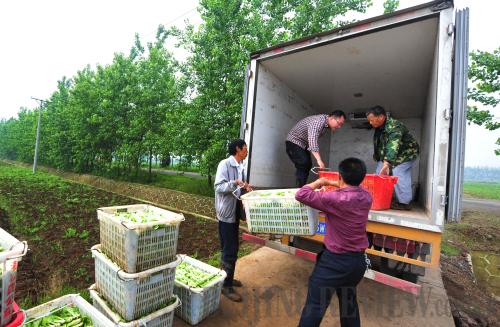|
 |
|
LOADING THE GREENS: Workers load fresh vegetables from a planting base in Wuhan, Hubei Province, on May 4, 2012. In early 2013, China adopted various measures to reduce circulation costs (CHENG MIN) |
Xinfadi wholesale market, located in the southern suburb of Beijing, is a major trading hub for farm and aquatic products. It supplies 70 percent of the vegetables and fruit sold in the city every day. As Chinese Lunar New Year is coming, rising vegetable prices worry many residents.
In an effort to cope with rising vegetable prices, the State Council recently issued a circular formulating 10 measures to ensure produce prices remain at a reasonable level, including reducing electricity and water prices and operational fees.
China's consumer price index (CPI) continued to fall in 2012, from 4.5 percent in January to 2.5 percent in December. However, farm produce prices didn't drop, but surged instead. According to figures collected by Xinfadi, prices of agricultural and sideline products on January 25 soared 105 percent from a year ago.
Geng Shuhai, Deputy Director of the Department of Trade of the National Development and Reform Commission, says the growth of vegetable prices is mainly due to circulation. Therefore among the 10 measures formulated by the State Council, four deal with the sector.
Figures from the China Federation of Logistics and Purchasing (CFLP) showed that in the January-November period in 2012, the country's logistics expenses totaled 8 trillion yuan ($1.27 trillion), a year-on-year increase of 11.9 percent, indicating that the overall logistics costs are still high.
Among total logistics expenses, management fees kept rapid growth. From January to November 2012, management fees totaled 1 trillion yuan ($159.24 billion), up 13.6 percent year on year. Transportation fees stood at 4.1 trillion yuan ($652.87 billion), up11.2 percent.
For fresh agricultural products, logistics costs account for 60 percent of the market price, said Zhang Yanlin, Research Director of China Investment Consulting. In developed countries, the figure is usually controlled below 10 percent.
Quite a lot of wealth in China is consumed in circulation, and high circulation costs also push prices high and weaken consumption capability, said Zhao Ping, Deputy Director of the Department of Consumer Economics at the Chinese Academy of International Trade and Economic Cooperation under the Ministry of Commerce.
However, logistics companies don't make money. "The profits of logistics companies are being squeezed," said Yun Mian, Operation Director of Delide Logistics Ltd. "In such a business, we are in a real dilemma."
Soaring oil prices, high tolls and growing labor costs are the reasons to blame for increasing logistics costs, said Yun, and high logistics costs will ultimately dampen the spending enthusiasm of consumers and curb economic growth.
Some of the 10 measures the State Council issued this time have been long desired by the industry and will bring some real benefits. It is commonly acknowledged that taxes and fees in the circulation sector should be reduced, but in practice, exemption or reduction of each tax or fee faces considerable resistance.
Hong Tao, a professor with the Beijing Technology and Business University, thinks the core problem in China's circulation sector is that it is less organized and there are too many links. The ultimate solution to reducing circulation costs includes innovation in circulation, improving information systems and nurturing core competitiveness among circulation enterprises.
| 